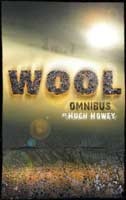Wool Omnibus by Hugh Howey
Wool is a story about survivors of a global catastrophe living in an underground silo. Poisonous air above, cold rock below, and an oppressive fascist system within. Humanity bottled up in a post-apocalyptic cliche.

ISBN: 1469984202
Broad Reach Publishing, 2012
English
A story about survivors of a global catastrophe living in an underground silo. Poisonous air above, cold rock below, and an oppressive fascist system within. A story where every part is meticulously crafted, but the whole ends up being less than the sum of its parts. (3/5)
What lifts Wool above being a formulaic story is the skill with which it is crafted. Hugh Howey is master of the vignette. He manages, quite unlike any other author that I know, to sculpt a scene in such a way as to make it a literary treat. Each scene has its own meticulously crafted and individual "taste". I'm so happy that I bought the e-book edition of Wool, because it lets me bookmark my favorite passages so I can return to just that part. Since finishing the book, I have returned to the best passages several times. It's like returning to the tastiest dishes of an already delicious buffet after having sampled them all. My favorite? The simply brilliant scene where Juliette is asked what a silo is[1].
Hugh Howey, however, is not master of the story, and Wool is less than the sum of its parts. The analogy of these scenes put in a greater story is not an all-you-can-eat buffet full of delicious dishes - it is the same delicious dishes poured into a blender and turned to mush. The scenes that stood on their own must suddenly work together. They must fit, not just with each other, but with the underlying premises of the story. Wool doesn't quite manage that.
For example, the silo in which the story takes place has one mode of transportation along its whole one-mile height: a small spiral staircase. There are no elevators - even freight elevators are absent. When pressed on this idiot design Howey replied that cheap and easy transportation made revolutions easier[2]. Too bad the inhabitants of the silo never learned this, because in the first few pages we learn that they have an uprising every 15-20 years or so. Further, Howey mentions Tunisia and Egypt as cases of cheap transport and communications resulting in revolutions. However, all Arab dictatorships had gone longer than 20 years before the uprisings, and the United States, a country known for their amount of cheap transportation, has gone a lot longer. So why the staircase?
Another telling example is the ending. Despite what the blurb tells you about the ending being something you can't guess, I'll go out on a limb and say that it is precisely what you would guess: Oppressive system smashed, freedoms restored. This brings us to the central problem with Wool, the dystopia itself.
Wool 1 was a short story, intended to stand alone. In a short story, one can accept a lot of facts about the environment, because the main story is usually something that takes place in that environment. But in Wool, the environment can't be ignored. Soon we start asking questions: Why are these people in a silo? What about the silo itself and its oppressive system of governance? Wool 1 was a story set in the silo; Wool is a story about the silo.
This takes us to the main problem with what the author has done. In order to make the dystopia believable, Howey has chosen to motivate it as being both planned and necessary - as opposed to, for example, making the dystopia the end result of a series of well-intentioned mistakes. But any motivation is clearly shown to be false, along with any claims of necessity, when the oppressive system is overcome.
As the book ends we are forced to conclude that the motivation for the utterly sadistic system of the silo boils down to the evil overlords doing it mostly for shits and giggles; making them in effect psychopaths on the order of Josef Fritzl[b] multiplied by the size of the universe.
I'm reminded of the computer game Fallout, which also takes place in a devastated world with people living in underground shelters called "vaults". However, in a twist of dark humor, the vaults were never intended to save anyone: The real reason for the existence of these vaults was to run social experiments on pre-selected segments of the population to see how they react to the stresses of isolation
[*][c]. This is how I end up seeing the over-arching story of Wool.
It's all a cruel joke; and it isn't even one that made me laugh.
Footnotes
[1] | Location 4927 / p. 313 in the Kindle edition |
[2] |
|